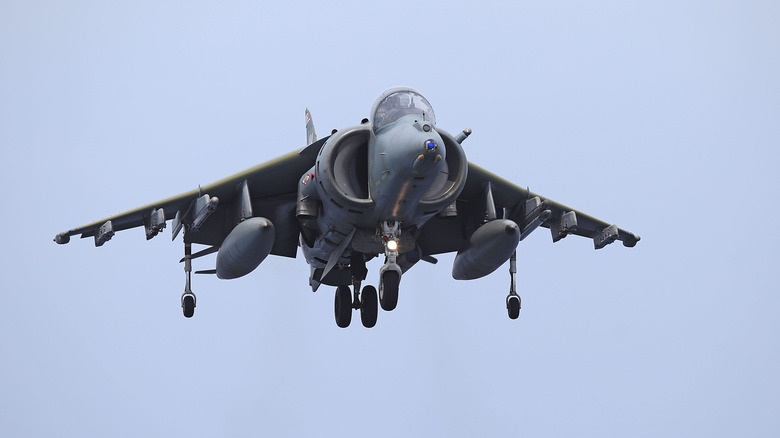
Christopher Furlong/Getty Images
In the last century, the world of aviation has changed significantly. Military aircraft have evolved from simple machines that couldn’t travel much faster than a car and were armed with a simple machine gun to sophisticated pieces of kit that can cost tens of millions of dollars each. They have also taken on an ever more important role in warfare, providing air support, defense against enemy aircraft, and striking at targets deep behind enemy lines.
While aircraft are traditionally associated with air forces, navies around the world also make use of all kinds of aircraft, from fighter jets and bombers to helicopters that can perform search and rescue missions. Often launched from carriers, these aircraft play a vital role in protecting ships and extending the range of naval forces as they traverse the oceans.
Here are nine of the best and most famous naval aircraft of all time, ranging from icons of the skies to legendary aircraft that were retired too soon.
McDonnell Douglas F/A-18 Hornet
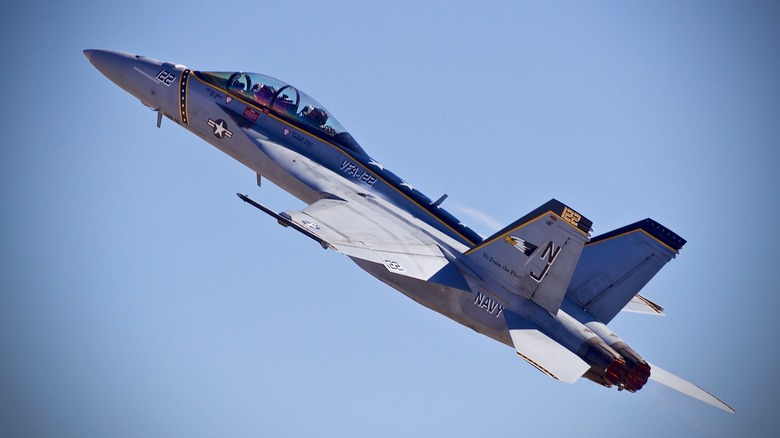
Niko Stock/Shutterstock
The McDonnell Douglas F/A-18 Hornet is a twin-engine multirole jet that was designed to be as versatile as possible. This is hinted at in its official designation, with the F/A section highlighting that it can be used as a fighter and an attack aircraft. It was largely based on the earlier YF-17 prototype and was developed throughout the 1970s. Recording its first flight in 1978, the aircraft entered active service in the early 1980s with the United States Navy and the United States Marine Corps.
Flexible and agile, the F/A-18 Hornet was a jet capable of acting as an escort for more vulnerable aircraft, providing air defense against enemy fighters, performing aerial reconnaissance, and giving air support to ground units. This versatility meant that the F/A-18 Hornet had to compromise in other areas, such as its maximum weapons payload and operational range, but it proved itself in combat throughout its history until it was retired in the 21st century. The aircraft saw action during the two Gulf Wars and was also involved in the bombing of Libya during Operation El Dorado Canyon.
While the Hornet is no longer in active service, its legacy lives on in the Boeing F/A-18E/F Super Hornet. The earlier fighter acted as the basis for the modern redesign, which was larger, more heavily armed, and capable of flying for longer than its predecessor.
MiG-29K
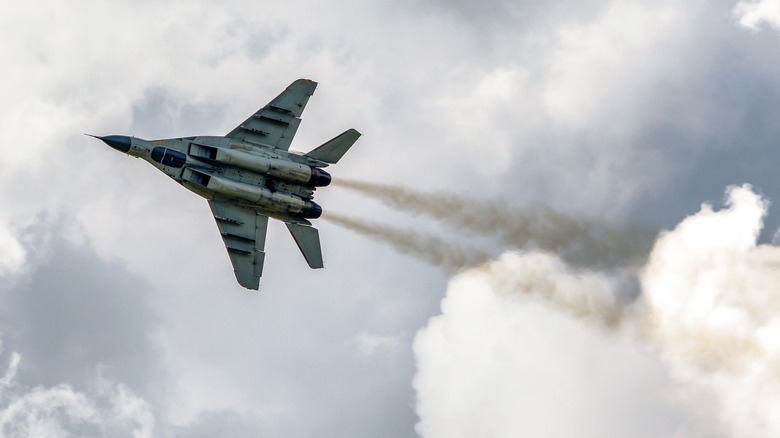
Jaroslav Moravcik/Shutterstock
The MiG-29 is a jet fighter that can be compared to the F-16. Created during the late 1970s at the height of the Cold War, the multirole aircraft entered service in 1983. Succeeding the earlier MiG-17, manufacturer Mikoyan intended it to be able to carry out a number of different roles, with a focus on establishing air superiority in a time of a constant arms race between the U.S. and the Soviet Union. To that end, it is agile, highly maneuverable, and able to excel in dogfights against other aircraft.
The MiG-29 proved to be a success, even if it didn’t quite have the same capabilities of the F-16, and was exported to a wide array of countries. In fact, the original MiG-29 design is still in use around the world today. Multiple variants were later developed, including the more advanced MiG-29M and the naval version known as the MiG-29K. This all-weather fighter can operate from aircraft carriers and has been used extensively by the Indian Navy as well as the Russian Navy.
Set to replace the Su-33, the MiG-29K first entered service in 2010 and over 80 have since been built. It features a number of improvements compared to the standard version, including a larger fuel tank and the ability to refuel in the air, in addition to folding wings to make it smaller when on deck.
Dassault Rafale
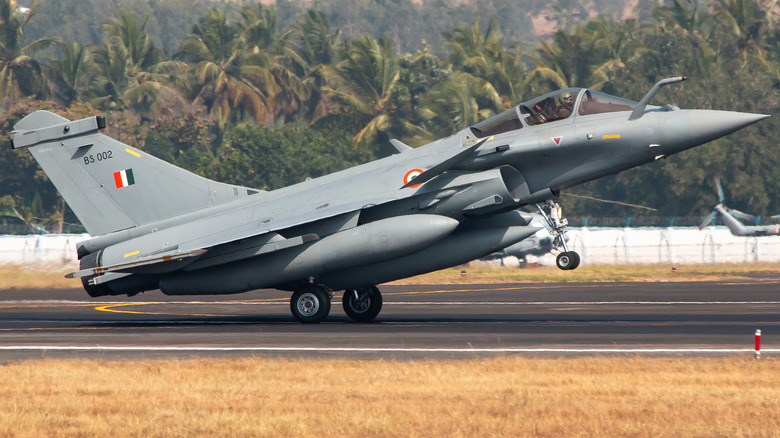
BoeingMan777/Shutterstock
Sometimes known as the Rafale Marine Fighter Jet in its naval variant, the twin-jet Dassault ‘Rafale’ is France’s answer to the Eurofighter Typhoon and other fourth-generation fighters. A multirole fighter that has some capabilities more closely associated with fifth-generation aircraft, including avionic systems such as advanced radar and 3D map generation. Developed during the late 1980s, the Dassault Rafale and its unique canard delta wing shape entered service 2001. It has since been exported to other operators, including Egypt, India, and Croatia.
The Dassault Rafale is used by the French Air and Space Force as well as the French Navy, with a variant known as the Rafale M featuring modifications so that it can take off and land on carriers using the CATOBAR system. This allows the jet fighter to take-off with the help of a catapult and land with the aid of arrestor wires to quickly slow them down.
The Dassault Rafale is one of the most capable fighters in the air today. With a top speed of Mach 1.8and the ability to carry nuclear warheads as a nuclear deterrent, it is capable of performing a wide array of tasks. Meanwhile, its distinctive appearance and operations in Afghanistan as part of Operation Enduring Freedom and attacks on ISIS in Iraq and Syria have made it famous worldwide.
Harrier jump jet
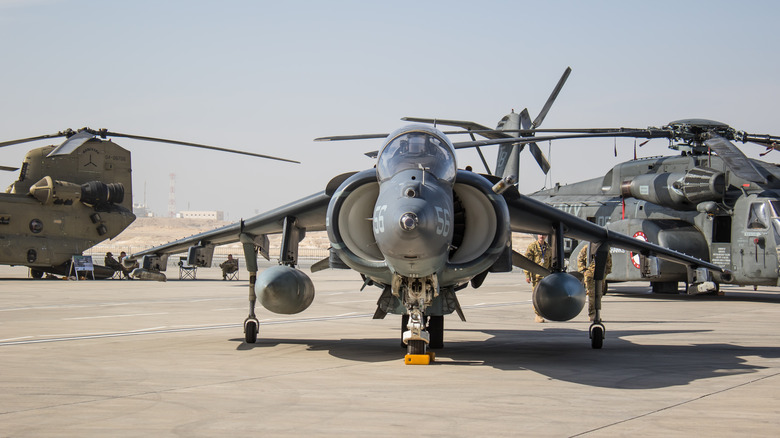
Ian Cramman/Shutterstock
The Harrier jump jet is the common name for a series of British aircraft that were initially designed by the UK-based aerospace company Hawker Siddeley before manufacturing was later taken on by Boeing and BAE Systems. Developed during the 1960s, the Harrier had its first flight in 1967 and entered service the same year. It was eventually exported to countries around the world and remained in operation with the Royal Air Force, the Royal Navy, the United States Marine Corps, and a range of European and Asian nations until relatively recently.
The most famous of the Harrier variants was the AV-8B Harrier II, a more powerful version of the aircraft that had been adapted for use on aircraft carriers. At the time of its introduction, the Harrier had some incredible capabilities and was the only true vertical/short takeoff and landing (V/STOL) jet. This meant it was able to get into the sky and safely land back on the ground without any forward momentum.
This was possible due to the fact it had four thrust nozzles that could be pointed in any direction, allowing it to move sideways and even hover in place. The abilities of the Harrier made it famous around the world and it saw active combat in the two Gulf Wars as well as military action in Afghanistan. The iconic nature of the aircraft was demonstrated when the Harrier was involved in a notable Pepsi giveaway commercial in 1996.
Lockheed Martin F-35 Lightning II
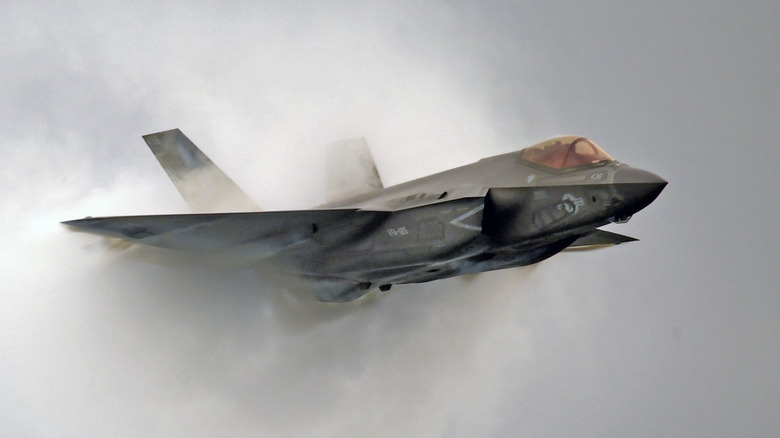
Nick Ut/Getty Images
The Lockheed Martin F-35 Lightning II is not just one of the most legendary naval aircraft ever but also among the very best fighter jets of all time. It is the United States’ second fifth-generation fighter after the F-22 Raptor and was intended to act as a cheaper alternative to the incredibly expensive fighter. This means it doesn’t have some of the same technological innovations and system capabilities of the F-22, such as its stealth elements. However, the F-35 was also designed to be more adaptable and flexible so that it could perform a larger range of tasks.
A collaboration between Lockheed Martin, Northrop Grumman, and BAE Systems, the F-35 entered service in 2015 after more than a decade of flight tests and training. The strengths of the F-35 lie in its potent weaponry and ability to strike quickly, with a top speed of Mach 1.6 and an operation range of more than 1,700 miles.
Two naval variants exist. The F-35B is a short take-off and vertical landing (STOVL) version of the aircraft that operates similar to the earlier Harrier jump jet. There’s also the F-35C, a variant that makes use of catapult-assisted take-off, barrier arrested recovery (CATOBAR) systems so that it can operate from aircraft carriers.
Westland Sea King
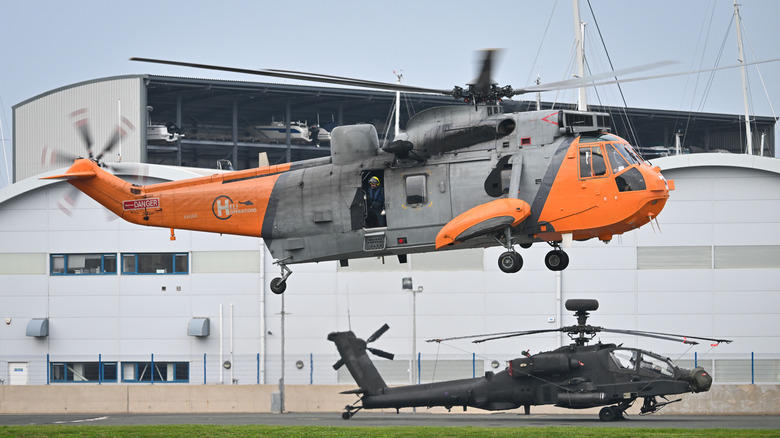
Finnbarr Webster/Getty Images
The Westland Sea King was a British helicopter that was based on the earlier American Sikorsky S-61. Put into full production in 1969, it entered active service the same year. They went on to become an integral part of the Royal Navy and were also used by the Royal Air Force as well as countries such as Germany, Australia, Egypt, and India. The helicopter quickly established a reputation for being reliable and able to operate in all conditions and environments, with the quality of the construction allowing for a long service life.
The Sea King saw combat in the 2003 Iraq War and the Falklands Conflict, where the aircraft was used as a troop transport and in logistical roles to deliver aid and equipment. Outside of warfare, the helicopter has often been used in disaster relief and humanitarian missions. Notable examples include Australian Westland Sea Kings, which were involved in aid efforts after the 2004 Indian Ocean earthquake and the 2010-11 Queensland floods.
There were also several variants of the Westland Sea King, including a Commando version that could carry up to 28 fully equipped troops and the Sea King AEW.2, which operated as an attack and defensive helicopter. Distinctive orange and yellow versions of the helicopter were common to see throughout the United Kingdom as Royal Navy Search and Rescue and RAF Search and Rescue Force aircraft.
LTV A-7 Corsair II
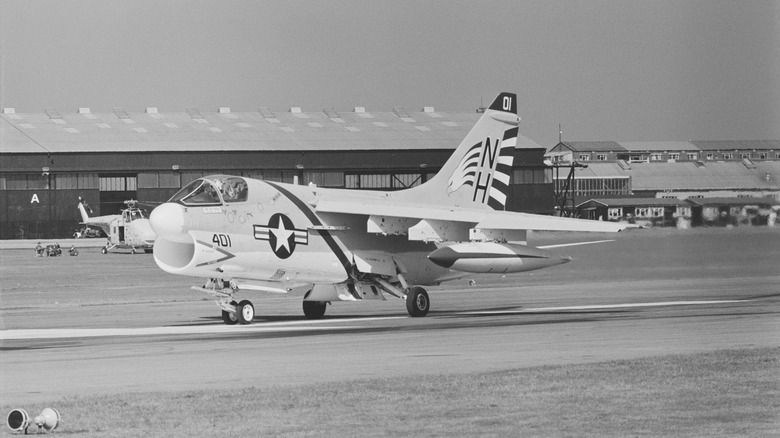
Evening Standard/Getty Images
Created by Ling-Temco-Vought, the LTV A-7 Corsair II is an American attack aircraft that was put into service in 1968 after several years of research and development throughout the 1960s. A versatile turbofan aircraft, the A-7 dominated the skies during the Vietnam War and the wider conflict in Laos and Cambodia. Designed as a replacement for the Douglas A-4 Skyhawk, this plane traveled at subsonic speeds and was able to take off from carriers and the ground.
Unlike its predecessor, the A-7 was created with the aim of being simple to manufacture and cheaper to produce. It went from prototype to combat in just a few years and proved itself as a valuable addition to the United States Navy. In fact, it performed so well that the United States Air Force and Air National Guard both ordered variants, as did other countries around the world such as Greece, Thailand, and Portugal.
More than 500 were delivered to the U.S. military, with the attack aircraft excelling in a number of roles. It was used mainly for ground strikes and air support but also took part in rescue missions and even operated as a fighter to establish air superiority over the battlefield. In terms of weaponry, it was outfitted with a M61A1 «Vulcan» 20mm rotary cannon and could carry up to 15,000 pounds of bombs and rockets.
Mitsubishi A6M Zero
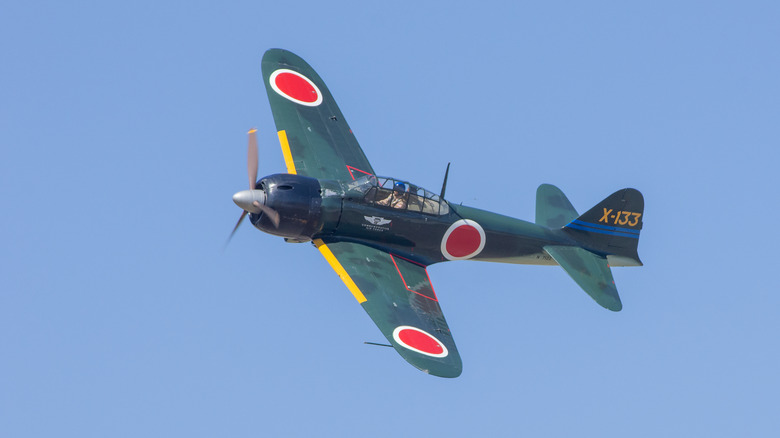
Angel DiBilio/Shutterstock
Allied forces during World War II had plenty of impressive naval aircraft. However, the Japanese military also had its fair share of effective and deadly fighters. Perhaps the most well known of them was the Mitsubishi A6M Zero. Designed and manufactured by Mitsubishi Heavy Industries, it acted as a carrier-based long-range fighter. Although it acted as a land-based fighter, it was most commonly associated with the Imperial Japanese Navy’s operations in the Pacific.
Intended to act as an air superiority fighter, the A6M Zero excelled in dogfighting and was often used as an escort for bombers and transport aircraft to clear the area of enemy targets. It led the infamous attack on Pearl Harbor and was a vital part of Japan’s early success in the wider war. Without the fighter, it is unlikely that the Axis powers would have been able to maintain combat in the Pacific for so long.
A legendary WWII plane, the A6M Zero was powered by a 1,130 horsepower engine that allowed it to reach a maximum speed of 350 mph. The fighter was armed with two 7.7-millimeter machine guns, two 20-millimeter cannons, and bombs that could be dropped on naval vessels or ground targets. At the time it entered service in 1940, it was arguably the most effective fighter in the world and caused carnage until Allied forces were able to produce comparable aircraft that were able to nullify the threat of the fighter and make it less effective.
Vought F4U Corsair
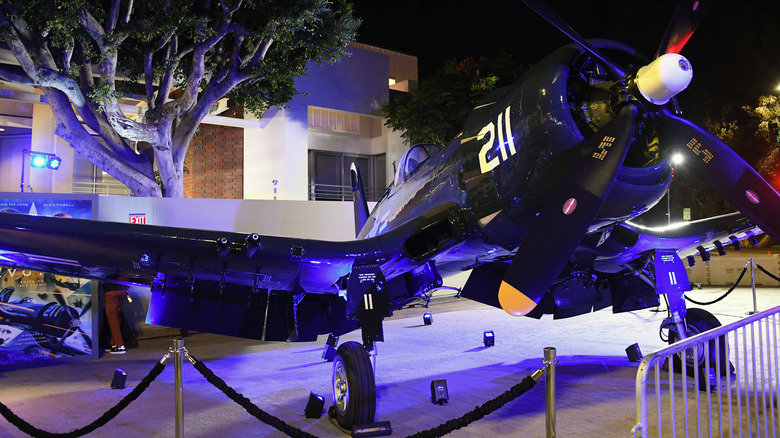
Albert L. Ortega/Getty Images
The Vought F4U Corsair was a fighter that made its debut during the Second World War and continued to be used up until after the Korean War. Designed and developed by American aerospace firm Chance Vought, work began on the aircraft before the start of the war. It was part of a proposal by the U.S. Navy Bureau of Aeronautics for manufacturers to create a single-engined fighter that was capable of meeting a number of stringent requirements. The outbreak of the conflict accelerated plans for its introduction and, after a prototype took to the skies in 1940, it entered service in 1942.
In many ways, the F4U Corsair was the Allies best weapon on the Pacific theater. It proved to be a formidable opponent to Japanese forces and was feared by enemy pilots due to its speed and firepower. A 2,000 horsepower 45.9-liter 18-cylinder radial Pratt and Whitney R-2800 engine gave the fighter enough thrust to travel at a top speed of 446 mph, while three .50 caliber machine guns on each wing gave it the ability to quickly shoot down any enemy targets. As a fighter-bomber, the F4U Corsair could also carry bombs and rockets for ground strikes or dropping on opposing aircraft squadrons. Operating from land by the Marine Corps and carriers by the Navy, it ended World War II with an 11-to-1 kill ratio.
Just how successful the F4U Corsair was is easy to judge. It was employed by other military forces around the world and was produced in numbers unheard of in modern times, with more than 12,000 leaving the production line over its lifetime. The U.S. retired the fighter in 1953 after production ended, although other countries used their fleet for longer, but by then it had established itself as an important part of naval history.